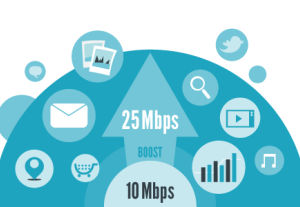Entering the world of fibre optic internet can be a confusing space, given the abundance of new jargon you have to understand. But, just like any new technology, it’s just a matter of picking up a few of the phrases before your feel completely at home with a once-foreign concept. To assist you in becoming one the in-crowd in terms of fibre optics – the best-performing, most reliable internet connection available – we’ve put together a glossary of the common terms you should know.
Business Fibre Glossary
Just to ease you in…
ADSL vs Fibre – ADSL internet is older technology that uses the standard copper phone lines to deliver internet access. The relatively new fibre internet uses plastic or glass cables for faster data transfer.
Capped vs uncapped internet – uncapped means you have unlimited data use, but there are more users allocated to share the bandwidth so it’s slower. With capped internet, there is a limited data amount but fewer users so it’s usually faster.
Fibre router – this is a device that connects you with the fibre internet through wired or Wi-Fi connectivity.
Fibre network vs fibre supplier – the network is a means of communication that connects to fibre internet, whereas the company that supplies this network is the supplier or Internet Service Provider (ISP).
Downstream or download speed – this is where fibre optic shows its true colours. It is the speed at which the user receives data from the internet.
Bandwidth – this is essentially the volume of information that the internet connection can handle per unit of time. So, the more bandwidth you have, the faster you can download and upload.
Read more: Telecommunications trends 2019
A few acronyms…
Fibre ONT (Optical Network Terminal) or modem – this is a device that connects to terminal points – devices – with fibre cable and then the router through LAN cable. ONT converts the signals from the fibre into electronic signals which are then read by the router.
FTTH (Fibre-to-the-Home) – this is the transference communication signals from the operator’s switching equipment through the fibre and to the home.
FTTN (Fibre-to-the-Node) – this is a way of providing communication services to more than one destination. Using a node – or network box – the FTTN provides broadband connection and other services.
FTTC (Fibre-to-the-Curb) – this is a process of installing fibre cables to curbs near retail, commercial and residential centres, replacing old telephone services.
Mbps (Megabits per second) – this is a unit of measurement for upload and download speeds.
MBps (Megabytes per second) – this is a unit of measurement for transferred data.
Read more: Business Fibre for corporates
Fibre optic cables …just in case
Cable – the fiber optic cable is a high-speed data transmission medium made up of several optic fibres bundled together with a glass core. This is where light signals are transmitted.
Jacket – the outer covering of the cable which protects against against moisture, abrasion, magnetic fields, radiation, and other elements.
Strength members – this is a component added to a jacketed cable, often made from Kevlar Aramid Yarn or even stiff, flexible fiberglass stem.
So, there you have it! Every word, acronym and all the terminology you need to know about fibre optic internet. The only thing now is to go out and find the perfect fibre supplier for all your speedy, efficient, reliable internet needs.
ECN is a leading telecommunications partner in South Africa. ECN offers a broad set of cost effective voice, data and hosted services to meet our customers ever growing technological needs. Our market leading fibre solutions provide our customers with the option of replacing their existing voice service provider to substantially reduce their monthly telecommunications bill. Contact ECN today for leading telecommunications solutions.

